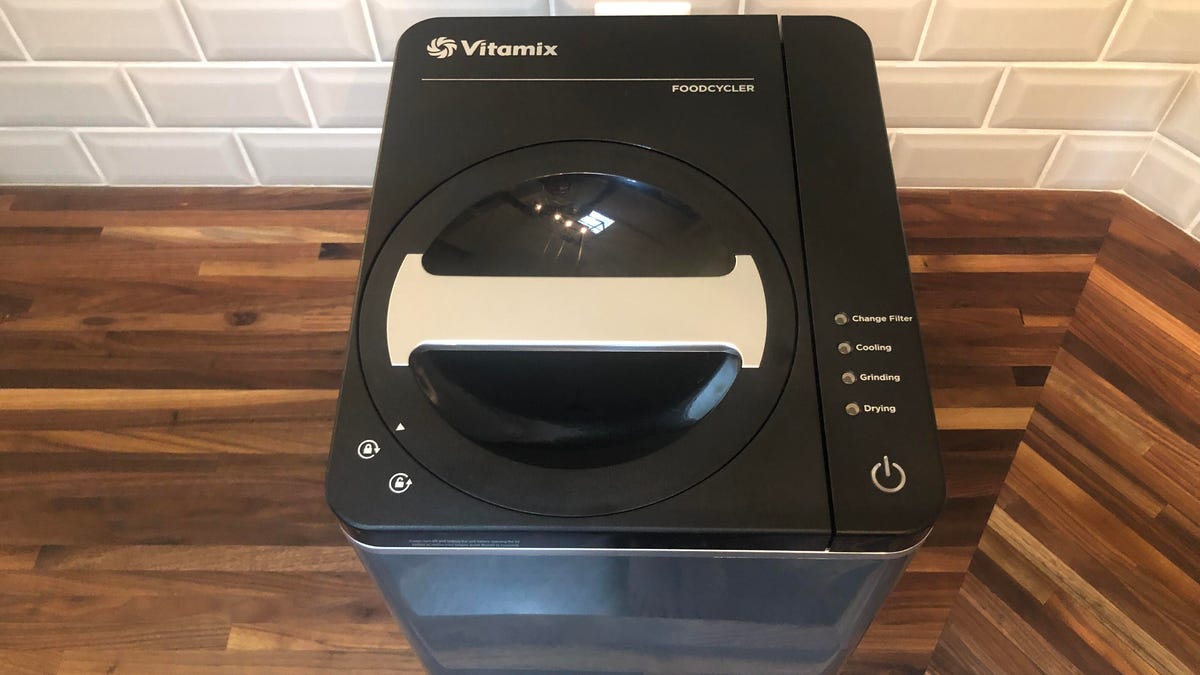The Vitamix FoodCycler FC-50 turns food scraps into fertilizer fast
It stays inside your house so you don't have to fend off backyard pests.

The FoodCycler converts compost inside your home.
Vitamix wants to put an end to food waste with its new $399.95 FoodCycler FC-50. Unlike traditional compost bins that are placed outside and gradually convert food waste to fertilizer over weeks and months, the plug-in FoodCycler stays inside your house and claims to do the job in just hours. Exactly how many hours depends on what you put in your FoodCycler, but Vitamix says each cycle should take between 4 and 8 hours.
I got my hands on a FoodCycler FC-50 and will be testing it out over the coming weeks in a more in-depth review. For now, let's take a look at its specs and features and talk through some initial impressions.
The product landscape
Not only is the FoodCycler FC-50 not the first indoor fertilizer appliance on the market, it isn't a first for Vitamix either -- this model is replacing the original Vitamix FoodCycler FC-30. Vitamix claims improvements over the first-gen model, including speedier cycles, increased filter life and a lid for the bucket to reduce smells.
This lid reduces smells.
Other companies have developed similar devices as well.
Back in 2014, we wrote about a product on Indiegogo by startup Food Cycle Science. Called the Food Cycler (two words rather than Vitamix's one), this white countertop appliance with neon green accents looked a lot like today's Vitamix FoodCycler, from its start button to the design of its locking lid. "The product in the 2014 story is not a Vitamix-branded product, although it was sold by the brand as the FC-30 model," a Vitamix spokesperson told me over email.
Whirlpool's WLabs sells a $599 appliance called the Zera Food Recycler. I got some hands-on time with the Zera back in 2016 and it's much larger than Vitamix's FoodCycler, but they do the same thing -- turn table scraps into fertilizer from inside your home.
Vitamix FoodCycler FC-50 initial thoughts
While it's considered a countertop device, the FoodCycler weighs a whopping 27 pounds and measures 14.3 inches tall and 11 inches wide with a depth of 12.6 inches. I have a small kitchen and would lose precious space if I kept the FoodCycler out on the counter all the time.
Fortunately, the bin inside that collects your food scraps is removable, which works much better in my kitchen. The bin is small -- only a little over a half-gallon -- and comes with a lid that's designed to reduce smells. I added a banana peel, coffee grounds and some onion scraps to my FoodCycler on the first day. It smelled strong until I put on the lid and then I couldn't even tell I had food in the bin.
According to Vitamix, adding a variety of foods is best for the FoodCycler (and for your soil). The company recommends adding fruit and vegetable scraps, with the exception of hard pits from avocados, peaches and other fruits -- or pineapple leaves. Citrus rinds and high-sugar fruits like bananas and grapes should be added sparingly. The FoodCycle can also handle meat scraps and chicken and fish bones, as well as cereal, cheese, eggs and eggshells, coffee grounds and filters, tea bags, legumes, beans, seeds and pet food.
The bin holds a half-gallon of food scraps.
Like citrus rinds and high-sugar fruits, Vitamix says it's all right to occasionally add starches like bread and rice, sauces, dressings and soups, nut butter and jam or jelly. Everything else, like candy, gum, cooking oil and beef or pork bones should not go in the FoodCycler.
There's a max fill line inside the bin to let you know when it's time to run a cycle. I haven't added enough scraps to start a cycle yet, but in theory, you should be able to simply place the bin inside the device, attach its locking lid, press the start button and wait for it to finish. Indicator lights on the top let you know its status, although there's no display to tell you exactly how much time is remaining. Once it's finished, you should have fertilizer to amend your existing soil. I'm curious whether it's noisy, so I'll be sure to report back on that after I've run a few cycles.
Note: If you're growing certain fruits, vegetables or plants, make sure to consider the nutrients they need before adding soil amendments. My blueberry plants, for example, need much more acidic soil than my cucumbers -- and the fertilizer made by the FoodCycler, depending on the scraps you add, might be good for one type of plant and not another.
That's it for now, but I'll be back later this month with a full review of the FoodCycler FC-50 to help you decide if it could be a worthwhile addition to your kitchen.
Read more: I've reached the 'making my own butter' phase of quarantine

